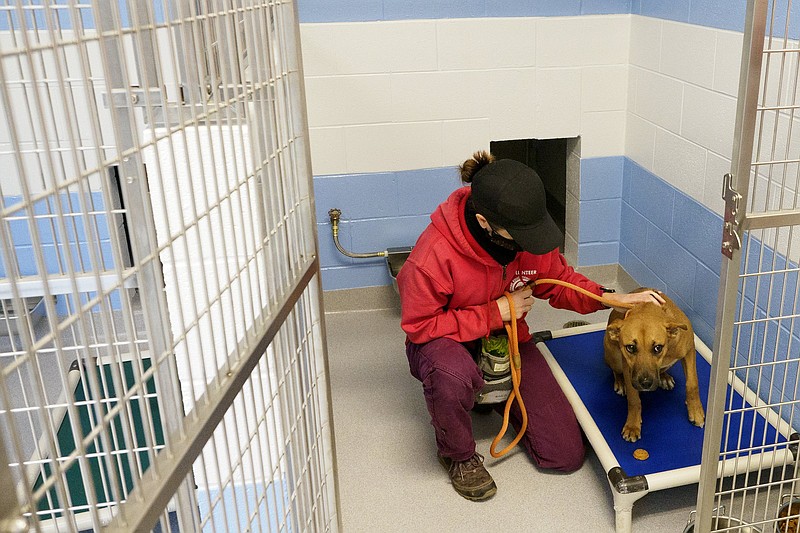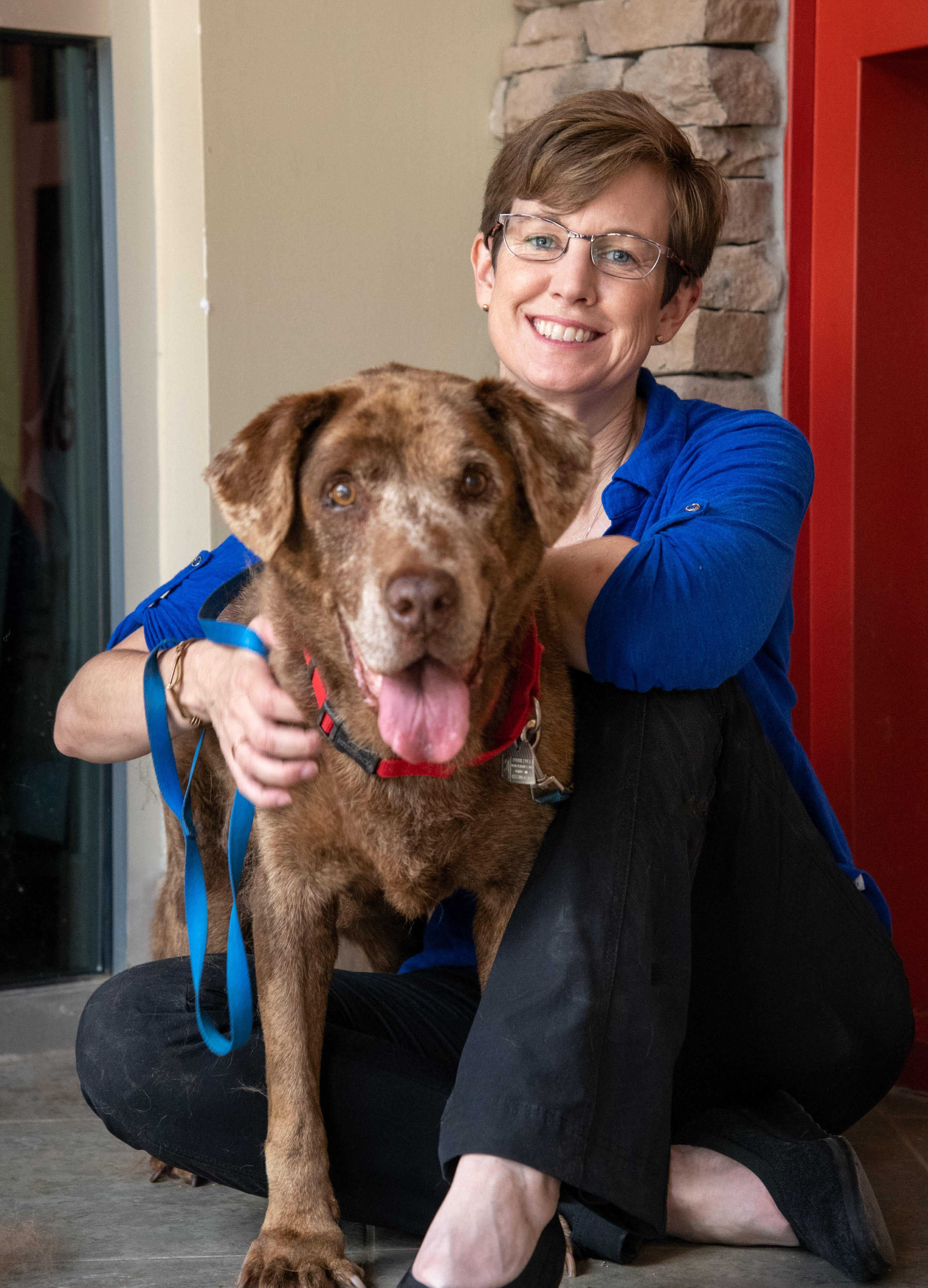Ask 31-year-old Rebecca Bryan, the new director of the Chattanooga Humane Educational Society, why she does what she does, and she will tell you it's because she can't imagine not doing it.
"The bond between people and pets is ancient and powerful," she says. "Companion animals are uniquely intertwined with us in our struggles because they live with us as family. They suffer with us in our poverty, homelessness, lack of access to care, neglect and indifference. Their problems are our problems."
Simply put, she does what she does because she wants to make a difference in the lives of companion animals and the people who love them.
The past year and a half has had its ups and downs for shelter animals. In 2020, the number of pets surrendered to shelters was down by half a million - a hopeful trend seen across the country, according to McKamey Animal Center's executive director, Inga Fricke. But by September 2021, McKamey was at capacity after a spike in intakes and staff shortages forced the shelter to turn animals away. Meanwhile, Chattanooga's HES was nearing capacity.
To better understand the current challenges in animal welfare, we asked Bryan and Fricke to share their experiences, plus their plans for better addressing the needs of our pets.
Challenges, multiplied
In many ways, the challenges facing the shelters are the same now as they've always been: There are more animals needing homes than there are homes for those animals. Moreover, access to routine veterinary care, as well as spay/neuter, is limited, particularly in low-income and outlying communities, which leaves shelters trying to pick up the slack. And shelter budgets are notoriously tight.
With the onset of COVID in 2020, existing challenges were multiplied.
Last year saw an overall reduction in animals entering the shelters when folks were staying home, says Bryan, but the lull was temporary. Some owners who fell into economic hardship were forced to relinquish their pets, although the number of people returning "pandemic pets" to shelters is not as high as shelters feared they might be. Even so, shelter populations have returned to pre-COVID numbers. The reasons for the population growth are multi-faceted. First, access to low-cost veterinary services and spay/neuter programs was severely limited last year - leading to a boom in unwanted litters. Bryan reports 950 juvenile and unweaned animals have come through HES this year so far.
Second, both McKamey and HES report that transports, which are volunteer drivers and pilots who ferry adoptable animals to high-demand areas such as Boston and Philadelphia - have been down this year due to COVID. So far, in 2021, just 500 HES animals were relocated to the northeast, compared to 763 animals by this time last year. And even if there were plenty of transports available, destination shelters can't take as many from shelters in need because their own populations are rising.
To complicate matters further, there continues to be widespread shelter staff and volunteer shortages - again, due to the pandemic - which has put increased pressure on existing staff.
According to a survey conducted by Best Friends Animal Society, 87% of the 137 shelters and partner organizations surveyed reported staff shortages. Even though McKamey took in 20% fewer animals this past summer compared to the previous summer, says Fricke, it feels overcrowded because staff members have had to handle more work.
Over at HES, there were eight animal care staff, one very part-time veterinarian and no vet techs for 300 animals for several months during the pandemic. One person handled the entire volunteer, foster and outreach programs combined. Two animal control officers were responsible for services for all of Hamilton County. Bryan herself was responsible for handling all adoptions, admissions, phone calls and inquiries.
The cost of running a shelter
As of late August, McKamey was housing over 450 animals, with more than 100 additional animals being cared for in foster homes. The cost of care for each animal varies, depending on their length of stay and their medical condition. (Animals with special conditions like those hit by cars or those suffering from heartworms can cost thousands of dollars to treat.) On average, Fricke estimates costs of care at $20-plus per day, per animal. Figure in operational costs, building upkeep, staff salaries and outreach programs, including the many community events and vet clinics, and it takes approximately $3.4 million to operate McKamey annually. A portion of the revenue comes from city contracts; the remainder must be raised through strategic partnerships and donations, and COVID has affected these as well.
"We've only been able to hold one major fundraising event [for McKamey] so far in 2021," says Fricke, "and overall giving is down this year by about 15%."
HES is currently providing for 222 animals in-house and 142 in foster care. Its physical capacity is 108 dogs and 180 cats.
"We have to stay below that threshold to have available housing for animals in need as an open-admissions facility," says Bryan, "and there are days the shelter takes in up to 40 animals." Costs of running HES last year were around $2.3 million; like McKamey, a portion of revenue comes from contracts while the rest must be made up through partnerships and donations. Both McKamey and HES have had to endure widespread COVID-induced nonprofit funding freezes.
Pet owners in need
The problem of access to care is perhaps the largest barrier to pet welfare, and the causes of it - and the solutions to it - are complex. In remote and low-income areas, it can be more difficult to access veterinary care than in other areas. There are fewer clinics, and it can be a challenge for working-class families to get to and afford vet services. The problem of animals not receiving care is not that their owners don't care about them, says Fricke, and the solution is not, as some might suggest, to remove those animals from their homes and place them in a shelter.
"I think almost everyone wants to do right by their pets," Fricke says, citing the success of various regional and international spay/neuter initiatives in remote-access areas she has been involved with. "These programs have proven, time and again, the love of pets is the same regardless of race, gender, ethnicity or economic status, and the only variable is the access to care."
She plans to expand McKamey's current outreach programs. While they already provide low-cost spay/neuter services, low-cost vaccine/microchip clinics, assist with feral cat trap/neuter/release (TNR), and deliver pet food to households in need (in July alone McKamey distributed over 800 pounds of food), she says that those on the front lines - the Animal Services Officers - are continually on the lookout for ways to help pet owners. Right now, says Fricke, the focus is on really exposing shelter pets to potential adopters. Through the K-9 to 5 program, shelter dogs can enjoy a day out of the shelter and in an office environment with people (and potential adopters). The annual Clear the Shelters adoption event has proven very successful, and the Trailblazer program (volunteers taking dogs for walks, hikes or runs) will be up and running soon. A "Spay the Momma" program, targeting community cats, is about to launch.
Like McKamey, HES hosts pop-up community clinics monthly. With the assistance of a volunteer veterinarian, they offer preventative services such as vaccination, parasite control and basic exams at rotating locations in Hamilton County, for low or no cost. They also deliver animal welfare education through schools and scout programs and participate in Clear the Shelter adoption events, to name just a few of their community service offerings.
"But," says Bryan, "the primary cause of care inequality is socioeconomic inequality, which is a much bigger problem than a shelter can solve. Veterinary costs are out of the question for so many people who struggle daily to meet the needs of their families and themselves. However, I believe that the human-animal bond transcends those limitations and that it is our obligation as a community to care for pets in need."
Options HES are exploring to increase overall wellness for pets include partnering with more volunteer vets to get more animals care, mobile clinics for greater access to spay/neuter and routine care, and veterinary social work - essentially, sending specially trained social workers into private homes to assess and formulate a plan for the animals and the people who care for them.
"Collaboration with veterinarians has proven to be the most effective way to address the issue [of access to care]. HES is paying close attention to national pilot programs with new, community-based [collaborative] approaches," and to this end, says Bryan, she invites any veterinarians who are curious about getting involved with shelter or community animals to reach out to her.
Lastly, says Bryan, it's important to understand why (and how) animal welfare advocates at times unintentionally fail the people and the animals they are trying to help.
Too often, she says, "the advocates want to be understood before trying to understand, which is fundamentally backward. Genuinely caring about people as part of the solution is essential to making a change. As James Evans of CARE (Companions and Animals for Reform and Equity) says, 'Only through love of humanity will we be able to meet people with curiosity and not [be] riddled with judgment and biases.'"
There is no hierarchy when it comes to who should be able to have and love an animal, just as there is no hierarchy when it comes to which animals deserve care. It is the mission and the responsibility of the shelters, with help from the communities they serve, to recognize and preserve the right to animal companionship and good veterinary care.
Want to help? Here's how you can be of the greatest assistance to the shelters in our area.
> Volunteer at the shelter or foster a shelter cat or dog. (There are a variety of volunteer roles, from laundry worker to gardener to dog walker to cat cuddler!)
> Adopt a cat or dog from a shelter rather than buying from a breeder.
> Share Facebook posts and shelter stories with your friends.
> Donate. (COVID has drastically affected the shelters' ability to raise funds. You can donate money and/or stocks; also, each shelter maintains a wish list of donate-able items on their website.)
> Remember shelters in your estate planning.


